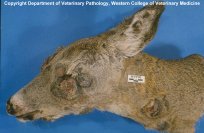|
|
| |
| Causative Agent |
-
Lumps, known as papillomas or warts, present on the skin and
mucous membranes are benign (non-cancerous)
tumors most often caused by the
papillomavirus group of
viruses.
|
| Images |
|
Click on
image to
enlarge. |
 |
|
Large, wart-like lesions are
fairly common on deer and moose. |
|
| Distribution |
|
|
| Hosts, Transmission and Life
Cycle |
| Hosts: |
-
Papillomas have been described in at least 50 mammalian species.
-
Most commonly observed in moose (Alces
alces) in BC, although white-tailed (Odocoileus
virginianus), black-tailed and mule deer (O. hemionus) are also reported to be affected occasionally.
|
|
Transmission: |
-
Occurs through direct contact with warts or
lesions of an infected animal that
contain
virus particles.
-
Transmission may also result
when infective
lesions are abraded by vegetation
that is subsequently in contact with uninfected hosts.
-
Bites of blood-feeding
invertebrates
(ticks,
mites, mosquitoes, etc.) may also
transfer the
virus.
-
Transmission usually occurs
among members of the same species or closely related
species. Reports have described areas where several animals
are affected over successive years.
|
|
Life Cycle: |
-
Once infected,
lesions may persist for weeks to
months.
-
75-80% of
lesions eventually regress, leaving
the host
immune to future infections.
-
The disease is often
self-limiting and lumps usually will disappear; therefore,
treatment and control in wild populations is not necessary.
|
|
| Signs and Symptoms |
-
Lesions
on
the skin and
mucous membranes.
-
Lesions
can be quite variable in
number (few to numerous), size (very small [1-2 mm] to huge [8-10 cm]), coloration (light to
dark) and texture (smooth to cauliflower-like in appearance).
-
Animals are generally in
good body condition but may become weak and debilitated if the
number and size of
tumors becomes unusually large or
when
tumors compromise vision or the
ability to eat.
-
Lesions
may
resemble those of
poxvirus infection in birds.
|
| Meat Edible? |
-
Meat from infected animals is suitable for human consumption since warts
do not affect the quality of the meat.
-
Trim off tissues containing warts prior to consumption for both humans
and domestic pets.
|
| Human Health Concerns and
Risk Reduction |
-
Although unsightly, papillomas are of no consequence to human health, as
humans cannot acquire warts from non-primate wild mammals.
|
| Samples for Diagnosis |
-
Gross and/or microscopic diagnosis is relatively straightforward.
-
After trimming excess tissue from wart, samples can
be placed in a household freezer (-20º C) prior to submission to a
suitable laboratory.
|
| Further Reading |
-
Alaska Department of Fish and Game – Papilloma
-
Alberta Environment and Sustainable Resource Development – Papilloma (PDF file)
-
Elkin B., Zamke R.L. 2001.
Common Wildlife Diseases and
Parasites in Alaska. Alaska Department of Fish and Game.
Anchorage, AK.
-
Sundberg J.P., Van Ranst M.,
Jenson A.B. 2001. Papillomavirus infections. Pp. 223-231 in E.S.
Williams, I.K. Barker (eds.),
Infectious Diseases of Wild Mammals. 3rd Ed. Iowa State
University Press. Ames, IA.
|
|
|
